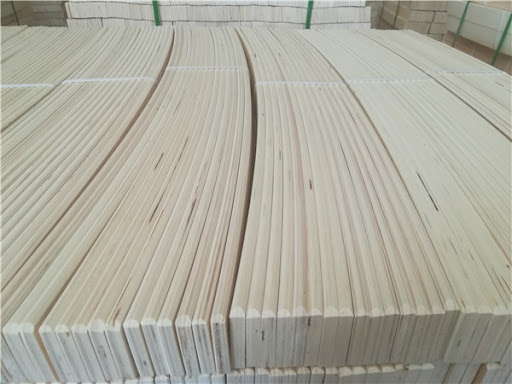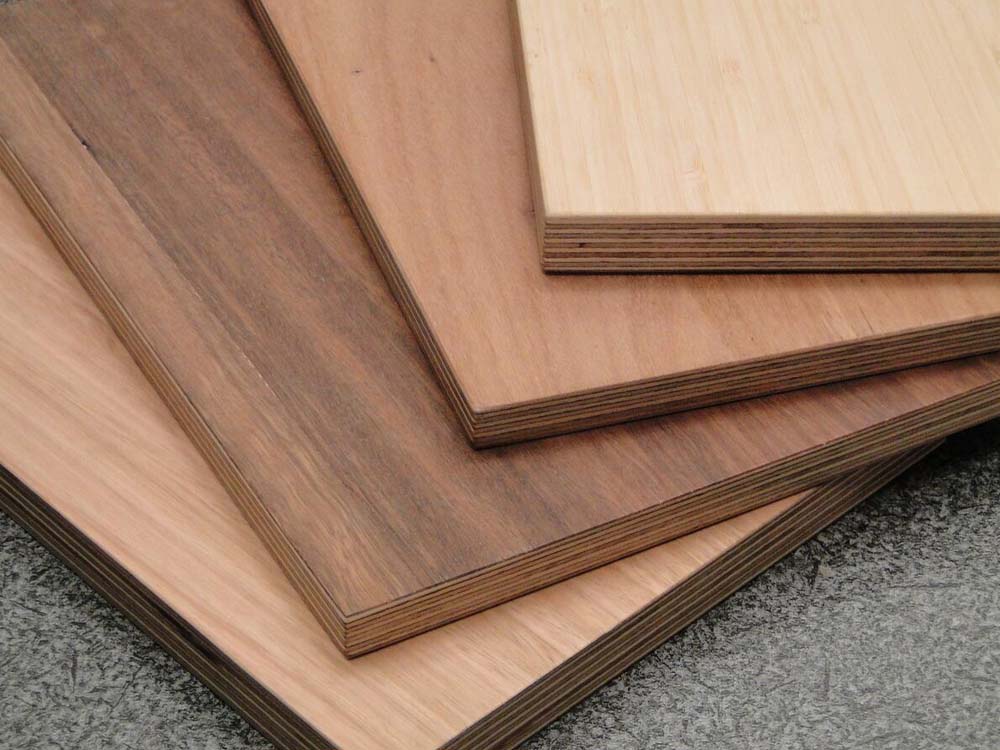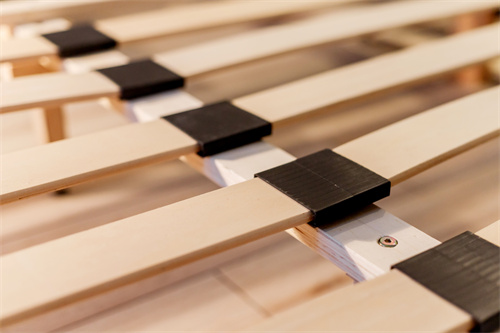Beliches - os melhores economizadores de espaço e um sonho de infância tornado realidade. Mas, para além da diversão e da funcionalidade, existe um componente crucial responsável por uma noite de sono segura e repousante: a ripa da cama, frequentemente negligenciada. E quando se trata de beliches, especialmente os construídos para crianças irrequietas, adolescentes em crescimento ou mesmo adultos, não é qualquer ripa que serve. Entrar LVL as ripas, os heróis desconhecidos do suporte robusto e fiável do beliche.
Porquê ripas LVL para beliches?
LVL significa Laminated Veneer Lumber (madeira folheada laminada) e foi concebida para uma resistência e consistência superiores, o que a torna uma escolha de topo para aplicações de mobiliário exigentes, especialmente beliches. Eis o porquê:
- Força inigualável: As ripas LVL apresentam uma relação resistência/peso excecional, muito superior à das ripas de madeira tradicionais. Isto traduz-se numa maior capacidade de carga, tornando-as ideais para beliches ocupados por crianças activas, adolescentes mais pesados ou adultos que procuram uma plataforma de dormir robusta e estável. Esta resistência inerente também contribui para a longevidade do beliche, garantindo que pode suportar anos de utilização sem comprometer o apoio.
- Desempenho consistente: Ao contrário da madeira maciça, que é propensa a empenar, torcer ou rachar ao longo do tempo devido a flutuações de temperatura e humidade, as ripas LVL são concebidas para uma estabilidade dimensional excecional. Isto significa que mantêm a sua forma e integridade estrutural ao longo do tempo, proporcionando um suporte consistente e evitando a flacidez do colchão, mesmo após anos de utilização e exposição a condições ambientais variáveis.
- Resistência à humidade: As ripas LVL apresentam uma maior resistência à absorção de humidade em comparação com a madeira maciça, o que as torna uma escolha particularmente adequada para climas húmidos ou divisões propensas à humidade. Esta resistência à humidade ajuda a evitar deformações, fissuras e outros danos relacionados com a humidade, prolongando assim a vida útil dos seus beliches e garantindo um desempenho a longo prazo.
- Opção amiga do ambiente: As ripas LVL são frequentemente fabricadas com madeira proveniente de florestas geridas de forma sustentável. Além disso, o seu processo de fabrico maximiza a utilização de cada tronco, minimizando o desperdício e contribuindo para uma abordagem mais responsável do ponto de vista ambiental. Isto torna-as uma escolha favorável para os consumidores que dão prioridade à sustentabilidade e a práticas ecologicamente conscientes.
Factores a considerar na escolha de ripas LVL para beliches
A seleção das lâminas LVL adequadas para os seus beliches envolve a consideração de vários factores-chave para garantir um suporte, segurança e longevidade ideais:
1. Dimensões das lâminas:
- Espessura: As ripas LVL mais espessas oferecem, por inerência, maior resistência e suporte, permitindo-lhes suportar cargas mais pesadas sem comprometer o desempenho. Para os beliches, recomenda-se geralmente uma espessura mínima de 20 mm (0,8 polegadas), com opções mais espessas disponíveis para quem procura uma capacidade de peso e durabilidade máximas, especialmente para utilizadores mais pesados ou pessoas mais activas.
- Largura: As ripas mais largas proporcionam uma superfície mais estável e uniforme para o colchão, distribuindo eficazmente o peso e minimizando o risco de flacidez ou desgaste irregular. Uma largura de, pelo menos, 63 mm (2,5 polegadas) é um bom ponto de partida, com opções mais largas disponíveis dependendo do design específico e dos requisitos de peso do beliche. As ripas mais largas também podem contribuir para uma experiência de sono mais confortável, minimizando a sensação de ripas individuais por baixo do colchão.
- Comprimento: O comprimento das ripas deve corresponder exatamente à largura da estrutura do beliche para garantir um encaixe confortável e seguro, evitando qualquer movimento ou instabilidade. A maioria dos fornecedores disponibiliza facilmente tamanhos padrão, mas podem ser encomendados comprimentos personalizados para estruturas de cama únicas ou requisitos de design específicos.
2. Espaçamento das ripas:
- Espaçamento mais próximo: Um espaçamento mais estreito entre as ripas cria uma base mais firme e de maior apoio para o colchão, evitando eficazmente a flacidez e assegurando uma distribuição uniforme do peso. Para os beliches, um espaçamento de 50-75 mm (2-3 polegadas) é geralmente considerado ideal, atingindo um equilíbrio entre apoio e respirabilidade. Um espaçamento mais estreito é particularmente importante para colchões ou indivíduos mais pesados, uma vez que ajuda a evitar que o colchão se afunde entre as ripas e comprometa o apoio.
- Espaçamento adicional: Embora um espaçamento maior entre as ripas possa criar uma sensação ligeiramente mais suave e flexível, pode não ser adequado para todos os tipos de colchões e pode levar a uma flacidez ou desgaste irregular ao longo do tempo, especialmente com colchões ou utilizadores mais pesados. Geralmente, não se recomenda um espaçamento maior para os beliches, uma vez que pode comprometer a estabilidade geral e o apoio da plataforma de dormir.
3. Quantidade de lâminas:
- Mais lâminas: A incorporação de um maior número de ripas na estrutura do beliche proporciona um maior apoio e uma distribuição de peso mais eficaz, contribuindo para uma vida útil mais longa das ripas e do colchão. O objetivo é ter pelo menos 10-14 ripas para um beliche normal de tamanho duplo e 12-16 ripas para um beliche de tamanho normal, ajustando para cima para cargas mais pesadas ou requisitos de design específicos. Um maior número de ripas também minimiza o espaço entre as ripas individuais, reduzindo a probabilidade de o colchão descair e melhorando o apoio geral.
- Menos lâminas: Optar por menos ripas, embora potencialmente tentador do ponto de vista do custo, pode comprometer significativamente o apoio geral e a longevidade do beliche, especialmente para indivíduos mais pesados ou que tendem a ser mais activos durante o sono. A utilização de um número demasiado reduzido de ripas pode levar à flacidez do colchão, a um desgaste irregular e a potenciais problemas estruturais ao longo do tempo, comprometendo, em última análise, a segurança e o conforto do beliche.
4. Caraterísticas adicionais:
- Calha de apoio central: Para beliches com uma largura maior, como os modelos de tamanho completo ou queen size, a incorporação de uma calha de suporte central a meio da estrutura da cama é crucial para manter a integridade estrutural e evitar a flacidez. Esta calha fornece apoio adicional às ripas, distribuindo o peso de forma mais uniforme e evitando que as ripas se curvem ou deformem sob pressão. Uma calha de apoio central é essencial para beliches maiores, garantindo a estabilidade a longo prazo e evitando problemas estruturais.

- Suportes de ripas: Os suportes das ripas, normalmente fabricados em plástico ou metal durável, são componentes essenciais que fixam as ripas de forma segura à estrutura da cama. Ajudam a manter as ripas corretamente alinhadas, evitam que se desloquem ou rangam durante a utilização e contribuem para a estabilidade geral e longevidade do beliche. Os suportes de ripas são particularmente importantes para os beliches, uma vez que ajudam a evitar que as ripas se desloquem durante a utilização, garantindo uma plataforma de dormir segura e protegida.
Comparação das ripas LVL com outras opções
| Caraterística | Lâminas LVL | Ripas de madeira maciça | Ripas metálicas |
|---|---|---|---|
| Força | Excelente | Bom (varia consoante a espécie de madeira) | Excelente |
| Durabilidade | Excelente | Bom (varia consoante a espécie de madeira) | Excelente |
| Consistência | Excelente | Razoável (propenso a deformações) | Excelente |
| Resistência à humidade | Bom | Razoável (propenso a deformações) | Excelente |
| Custo | Moderado | Baixo a elevado (varia consoante a espécie de madeira) | Elevado |
Fazer a escolha certa para um sono seguro e tranquilo
Escolher as ripas LVL corretas para os seus beliches é um investimento em segurança, durabilidade e uma boa noite de sono. Ao compreender os factores envolvidos e ao considerar as necessidades únicas do design do seu beliche, pode garantir uma base de apoio e duradoura para os próximos anos.
Aqui está uma rápida recapitulação do que deve ser prioritário ao selecionar as ripas LVL para beliches:
- Resistência e durabilidade: Opte por ripas mais grossas e largas para suportar cargas mais pesadas e resistir à deformação.
- Espaçamento ótimo: Escolha um espaçamento mais estreito entre as ripas para um apoio mais firme e para evitar que o colchão descaia.
- Quantidade suficiente: Utilize um número suficiente de ripas para assegurar uma distribuição adequada do peso e evitar a sua queda.
- Apoio adicional: Considere uma calha de apoio central para beliches mais largos e utilize suportes para fixar as ripas no lugar.
Seguindo estas diretrizes, pode escolher com confiança as ripas LVL que proporcionarão uma experiência de sono segura, de apoio e confortável para todos os que desfrutam da diversão e funcionalidade dos seus beliches.
Perguntas frequentes sobre as ripas LVL para beliches
1. O que faz com que as ripas LVL sejam uma melhor escolha para beliches do que as ripas de madeira tradicionais?
As ripas LVL são concebidas para uma força, consistência e resistência à humidade superiores às ripas de madeira maciça. Isto torna-as ideais para beliches, que têm de suportar cargas mais pesadas e forças mais dinâmicas, especialmente com crianças envolvidas. As ripas LVL são menos susceptíveis de deformar, rachar ou ceder, garantindo uma vida útil mais longa para os seus beliches.
2. Como é que determino o espaçamento correto entre as ripas do meu beliche?
Um espaçamento mais estreito entre as ripas (2-3 polegadas) proporciona geralmente um apoio mais firme, o que é ideal para os beliches. No entanto, o espaçamento ideal também depende do tipo de colchão e do peso dos utilizadores. Se não tiver a certeza, consulte as recomendações do fabricante do colchão ou opte por um espaçamento mais estreito para um melhor apoio.
3. Posso utilizar as ripas LVL para qualquer tipo de beliche?
Sim, as ripas LVL são versáteis e podem ser utilizadas para vários designs de beliches, incluindo camas twin-over-twin, full-over-full e camas loft. Certifique-se apenas de que escolhe as dimensões corretas das ripas (espessura, largura, comprimento) para corresponder à sua estrutura de cama específica e aos requisitos de peso.
4. Preciso de uma calha de suporte central para o meu beliche se estiver a utilizar ripas LVL?
Embora as ripas LVL sejam incrivelmente fortes, recomenda-se vivamente uma calha de apoio central para beliches mais largos (tamanho completo ou queen size). Este suporte adicional ajuda a distribuir o peso de forma mais homogénea, evitando possíveis flacidez e garantindo a longevidade das ripas e da estrutura da cama.
5. Onde posso comprar ripas LVL de alta qualidade para o meu projeto de beliche?
Muitos fornecedores de madeira de renome e fabricantes de componentes para mobiliário oferecem ripas LVL. Ao escolher um fornecedor, dê prioridade aos que se especializam em LVL de qualidade para mobiliário e que oferecem uma gama de dimensões e opções de personalização para satisfazer as suas necessidades específicas. Certifique-se de que os materiais são adquiridos de forma responsável e que cumprem as normas de controlo de qualidade para um desempenho e longevidade ideais.



